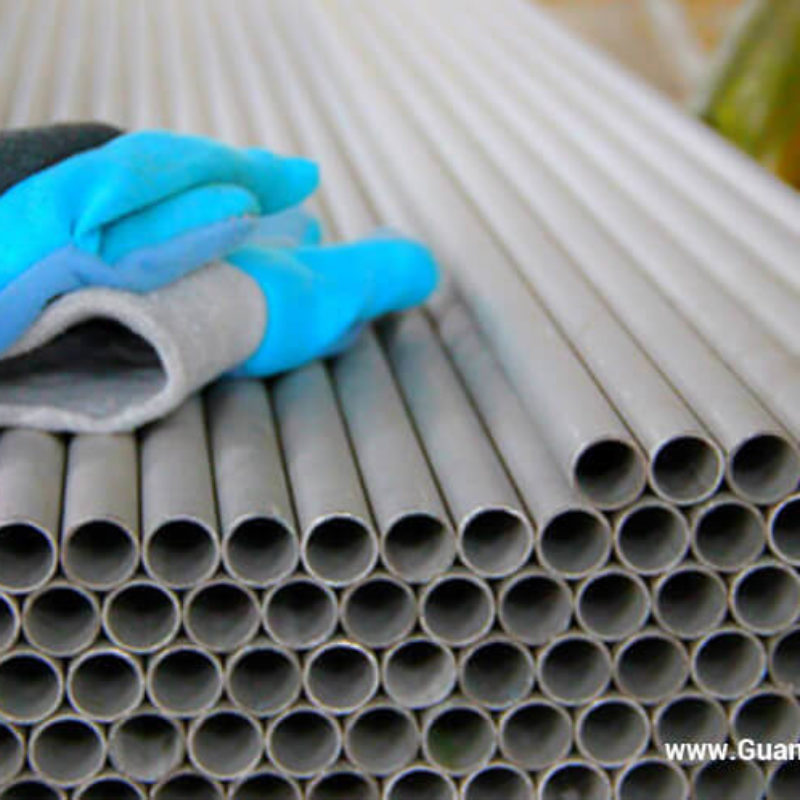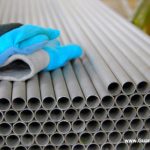304 Stainless Steel Tube ASTM A213 ASME SA 304 Stainless Steel Tubes
Request for QuotationASME SA 213 / ASTM A213 304 stainless steel tube is a variation of the 18% chromium – 8% nickel austenitic stainless steel tube, the most familiar and most frequently used alloy in the stainless steel family. This stainless steel be considered for a wide variety of application on good corrosion resistance, ease fabrication, excellent formability, and high strength with low weight.
304 Stainless Steel Tube is the standard “18/8” stainless steel; it is the most versatile and most widely used stainless steel, available in a wider range of products, forms and finishes than any other. It has excellent forming and welding characteristics. The balanced austenitic structure of Grade 304 enables it to be severely deep drawn without intermediate annealing, which has made this grade dominant in the manufacture of drawn stainless steel part such as sink, hollow-ware and saucepan. For these application it is common to use special “304DDQ” (Deep Drawing Quality) variants.
304 Stainless Steel Tube is readily brake or roll formed into a variety of components for application in the industrial, architectural, and transportation fields. Grade 304 also has outstanding welding characteristic. Post-weld annealing is not required when welding thin sections.
Grade 304L, the low carbon version of 304, does not require post-weld annealing and so is extensively used in heavy gauge component (over about 6mm). Grade 304H with its higher carbon content finds application at elevated temperature. The austenitic structure also gives these grades excellent toughness, even down to cryogenic temperature.
Table 1. Chemical Composition for ASME SA 213 ASTM A213 304 304L 304H
| Grade | – | C | Mn | Si | P | S | Cr | Mo | Ni | N |
| 304/S30400 | min.max. | -0.08 | -2.0 | -1.00 | -0.045 | -0.030 | 18.0-20.0 | – | 8.0-11.0 | – |
| EN 10216-5 1.4301 | min.max. | -0.07 | -2.0 | -1.00 | -0.040 | -0.015 | 17.00-19.5 | – | 8.0-10.5 | -0.11 |
| 304L/S30403 | min.max. | -0.035 | -2.0 | -1.00 | -0.045 | -0.030 | 18.0-20.0 | – | 8.0-12.0 | – |
| EN 10216-5 1.4307 | min.max. | -0.030 | -2.0 | -1.00 | -0.040 | -0.015 | 17.5-19.5 | – | 8.0-10.0 | -0.11 |
| 304H /S30409 | min.max. | 0.04-0.10 | -2.0 | -1.00 | -0.045 | -0.030 | 18.0-20.0 | – | 8.0-11.0 | – |
| EN 10216-5 1.4948 | min.max. | 0.04-0.08 | -2.0 | -1.00 | -0.035 | -0.015 | 17.0-19.0 | – | 8.0-11.0 | -0.11 |
Typical Mechanical Properties for grade 304 stainless steel are given in table 2.
Table 2. 304 Stainless Steel Tube Mechanical properties
| – | Tensile Strength | Yield Strength | Elongation | Hardness | Hardness |
| Grade | (MPa) min | 0.2% Proof (MPa) min | (% in 50mm) min | Rockwell B (HR B) max | Brinell (HB) max |
| 304 | 515 | 205 | 35 | 90 | 192 |
| 304L | 485 | 170 | 35 | 90 | 192 |
| 304H | 515 | 205 | 35 | 90 | 192 |
- ASTM: TP304L, TP304
- UNS: S30403, S30400
- EN Number: 1.4306, 1.4301
- W.Nr.: 1.4306*, 1.4301*
- DIN: X 2 CrNi 19 11*, X 5 CrNi 18 10*
- AFNOR: Z 2 CN 18.10*
- BS: 304S31*, 304S11*
- JIS: SUS304L, SUS304LTB, SUS304TP
Product standards
- ASTM A213, A269 and A312
- JIS G3459
- JIS G3463
- EN 10216-5
- BS 3605, 3606*
- DIN 17456, 17458*
- NFA 49-117, 49-217
- SS 14 23 52, 14 23 33*
* Obsolete. Replaced by EN.
304 Stainless Steel is used for a wide range of industrial applications. Typical application are: heat exchangers, condensers, pipelines, cooling and heating coils in the chemical, petrochemical, fertilizer, pulp and paper and nuclear power industries, as well as in the production of pharmaceuticals, foods and beverages.
General corrosion
304 Stainless Steel has good resistance in
- Organic acids at moderate temperatures
- Salt solutions, e.g. sulfates, sulfides and sulfites
- Caustic solutions at moderate temperatures
304 Stainless Steel Tube are normally delivered in heat treated condition. If additional heat treatment is needed after further processing the following is recommended.
Stress relieving
850-950 °C (1560-1740 °F), cooling in air.
Solution annealing
1000-1100°C (1830-2010°F), rapid cooling / Quenching in water.




Referenced Documents
1 Stainless Steel and Related Alloys and is the direct responsibility of Subcommittee A01.10 on Stainless and Alloy Steel Tubular Products. Current edition approved April 1, 2009. Published April 2009. Originally approved in 1939. Last previous edition approved in 2009 as A 213/A 213M – 09.
2 For ASME Boiler and Pressure Vessel Code applications see related Specification SA-213 in Section II of that Code.
ASTM A262 Practices for Detecting Susceptibility to Intergranu lar Attack in Austenitic Stainless Steel
A 941 Terminology Relating to Steel, Stainless Steel, Re lated Alloys, and Ferroalloys
A 1016/A 1016M Specification for General Requirements for Ferritic Alloy Steel, Austenitic Alloy Steel, and Stainless Steel Tubes
ASTM E112 Test Methods for Determining Average Grain Size
Nominal Pipe Size (NPS): 1/8, 1/4, 3/8, 1/2, 3/4, 1, 1 1/4, 1 1/2, 2, 2 1/2 inch
Outside Diameter: 10,3 – 73 mm (0,405 – 2,875 inch)
Wall Thickness: 1,24 – 7,01 (0,049 – 0,276 inch)
Tensile Requirements
| Grade | UNS Designation | Tensile Strength, Min ksi [MPa] | Yield strength, min ksi [MPa] | Elongation in 2 in. or 50 mm, min, %A, B | Hardness, Brinell/Vickers Max | Hardness, Rockwell Max |
| TP304 | S30400 | 75 [515] | 30 [205] | 35 | 192HBW/200Hv | 90HB |
| TP304L | S30403 | 70 [485] | 25 [170] | 35 | 192HBW/200Hv | 90HB |
| TP304H | S30409 | 75 [515] | 30 [205] | 35 | 192HBW/200Hv | 90HB |
| TP304N | S30415 | 80 [550] | 35 [240] | 35 | 192HBW/200Hv | 90HB |
| TP310S | S31008 | 75 [515] | 30 [205] | 35 | 192HBW/200Hv | 90HB |
| TP310H | S31009 | 75 [515] | 30 [205] | 35 | 192HBW/200Hv | 90HB |
| TP316 | S31600 | 75 [515] | 30 [205] | 35 | 192HBW/200Hv | 90HB |
| TP316L | S31603 | 70 [485] | 25 [170] | 35 | 192HBW/200Hv | 90HB |
| TP316H | S31609 | 75 [515] | 30 [205] | 35 | 192HBW/200Hv | 90HB |
| TP316Ti | S31635 | 75 [515] | 30 [205] | 35 | 192HBW/200Hv | 90HB |
| TP317 | S31700 | 75 [515] | 30 [205] | 34 | 192HBW/200Hv | 90HB |
| TP317L | S31703 | 75 [515] | 30 [205] | 35 | 192HBW/200Hv | 90HB |
| TP321 | S32100 | 75 [515] | 30 [205] | 35 | 192HBW/200Hv | 90HB |
| TP321H | S32109 | 75 [515] | 30 [205] | 35 | 192HBW/200Hv | 90HB |
| TP347 | S34700 | 75 [515] | 30 [205] | 35 | 192HBW/200Hv | 90HB |
| TP347H | S34709 | 75 [515] | 30 [205] | 35 | 192HBW/200Hv | 90HB |
| TP444 | S44400 | 60 [415] | 40 [275] | 20 | 217 HBW/230HV | 96HB |
Heat Treatment Requirements
| Grade | UNS Designation | Heat Treat Type | Austenitizing/ Solutioning Temperature, min or range °F [°C] | Cooling Media | ASTM Grain Size No. B |
| TP304 | S30400 | Solution treatment | 1900 °F [1040 °C] | water or another rapid cool | . . . |
| TP304L | S30403 | Solution treatment | 1900 °F [1040 °C] | water or another rapid cool | . . . |
| TP304H | S30409 | Solution treatment | 1900 °F [1040 °C] | water or another rapid cool | 7 |
| TP309S | S30908 | Solution treatment | 1900 °F [1040 °C] | water or another rapid cool | . . . |
| TP309H | S30909 | Solution treatment | 1900 °F [1040 °C] | water or another rapid cool | 7 |
| TP310S | S31008 | Solution treatment | 1900 °F [1040 °C] | water or another rapid cool | . . . |
| TP310H | S31009 | Solution treatment | 1900 °F [1040 °C] | water or another rapid cool | 7 |
| TP316 | S31600 | Solution treatment | 1900 °F [1040 °C] | water or another rapid cool | . . . |
| TP316L | S31603 | Solution treatment | 1900 °F [1040 °C] | water or another rapid cool | . . . |
| TP316H | S31609 | Solution treatment | 1900 °F [1040 °C] | water or another rapid cool | 7 |
| TP317 | S31700 | Solution treatment | 1900 °F [1040 °C] | water or another rapid cool | . . . |
| TP317L | S31703 | Solution treatment | 1900 °F [1040 °C] | water or another rapid cool | . . . |
| TP321 | S32100 | Solution treatment | 1900 °F [1040 °C] | water or another rapid cool | . . . |
| TP321H | S32109 | Solution treatment | cold worked:2000[1090] hot rolled: 1925 [1050]H | water or another rapid cool | 7 |
| TP347 | S34700 | Solution treatment | 1900 °F [1040 °C] | water or another rapid cool | . . . |
| TP347H | S34709 | Solution treatment | cold worked:2000[1100] hot rolled: 1925 [1050]H | water or another rapid cool | 7 |
| TP444 | S44400 | subcritical anneal | . . . | . . . | . . . |
Flattening Test
One flattening test shall be made on specimens from each end of one finished tube, not the one used for the flaring test, from each lot.
Flaring Test
One flaring test shall be made on specimens from each end of one finished tube, not the one used for the flattening test, from each lot.
Hydrostatic or Nondestructive Testing
Each pipe shall be subjected to the nondestructive electric test or the hydrostatic test, the type of test to be used shall be at the option of the manufacturer, unless otherwise specified in the purchase order.
Markings
Markings will adhere to prescribed specifications in A999/A999M and shall include the NPS or OD and schedule number or average wall thickness, heat number, and NH (when hydrotesting is not performed) and ET (when eddy-current testing is performed) or UT (when ultrasonic testing is performed). The marking shall also include the manufacturer’s private identifying mark, the marking requirement of section 12.3 on Hydrostatic or Nondestructive Electric Test, if applicable, and whether seamless (SML), welded (WLD), or heavily cold-worked (HCW). For Grades TP304H, TP316H, TP321H & TP347H, the marking shall also include the heat number and heat-treatment lot identification.
Note:
- Mill test certificates will be issued according to EN10204.3.
- All tubes shall be supplied as per applicable ASTM A213 /A213M Specification.
Notes:
- Steel Grades – TP 304, TP 304L, TP 316, TP 316L, TP 321
- Technical requirements acc. to ASTM A 450.
- Size of pipes in accordance with ANSI/ASME B36.19M.
- The quality of pipes is ensured by manufacturing process and non-destructive test.
- Hardness of metal not less than 100 HB.
- Length tolerance of measured pipes not greater than +10 mm.
- Monitoring of continuity of metal by pneumotest with pressure of 6 bar is available.
- Intergranular corrosion test in accordance with ASTM A262, Practice E is available.


